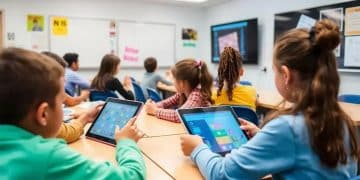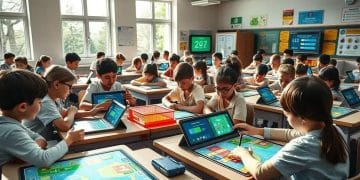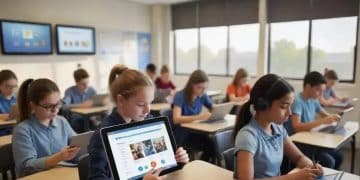VR learning environments trends shaping future education
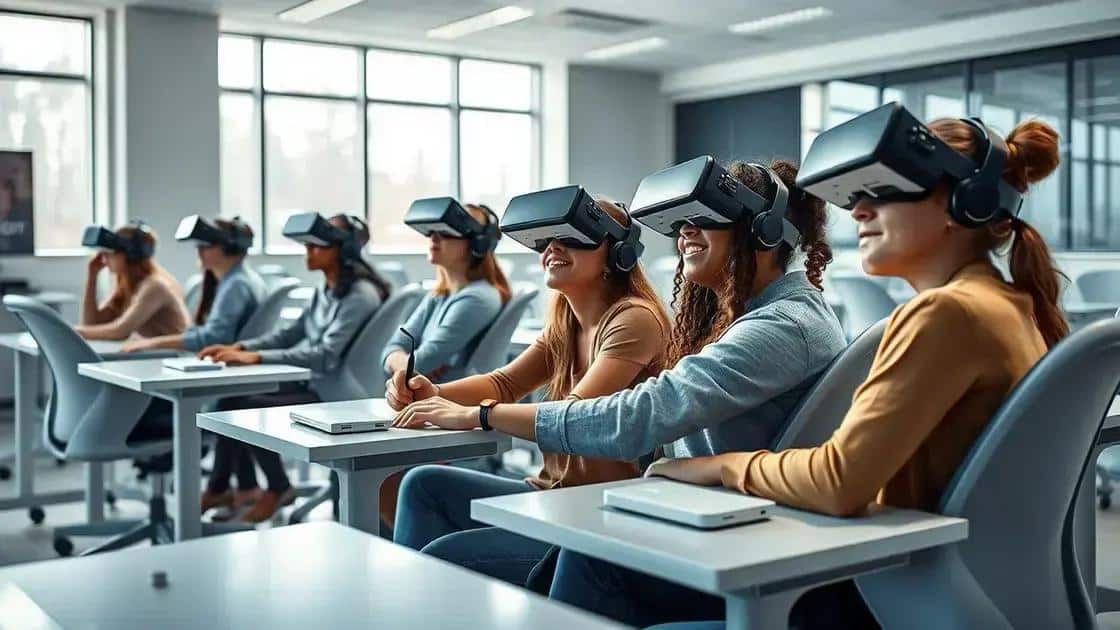
VR learning environments enhance education by providing immersive, interactive experiences that boost engagement, facilitate personalized learning, and promote collaboration among students and educators.
VR learning environments trends are transforming the educational landscape, offering immersive experiences that deepen understanding. Have you ever wondered how these technologies can enhance what you learn?
Exploring the evolution of VR in education
Virtual reality (VR) technology in education has come a long way. It started as a niche concept and has now become a vital tool for enhancing learning experiences. Many educators are curious about how VR learning environments can make a difference in the classroom.
Key Milestones in VR Evolution
The journey of VR in education is highlighted by significant milestones. One of the initial steps was the development of simple VR simulations. These allowed students to explore different environments without leaving the classroom. As technology advanced, the simulations became more complex and immersive, engaging students on a deeper level.
More recently, the introduction of affordable VR headsets made it possible for schools to integrate these technologies into their curriculum. By providing interactive learning opportunities, VR has transformed traditional teaching methods.
Benefits of VR in Education
- Enhanced engagement through immersive experiences.
- Opportunities for experiential learning that were previously difficult to achieve.
- Ability to visualize complex concepts, improving understanding.
As students step into these virtual worlds, their motivation increases, leading to improved learning outcomes. With the capability to interact with the material in a hands-on manner, students often grasp concepts faster and retain information better.
In addition to engagement, VR can foster collaboration among students. Many platforms enable multiple users to enter the same virtual environment. This encourages teamwork and communication skills, which are crucial for their future careers.
Future Trends
Looking ahead, the future of VR learning environments seems bright. With continuous advancements, we can expect to see more sophisticated educational content that adapts to individual learning styles. Additionally, the integration of artificial intelligence into VR experiences could provide personalized learning pathways for each student.
The merging of these technologies is likely to create more effective, customized learning environments. Educators are excited about the possibilities and are eager to incorporate these innovations into their teaching practices.
Benefits of VR learning environments
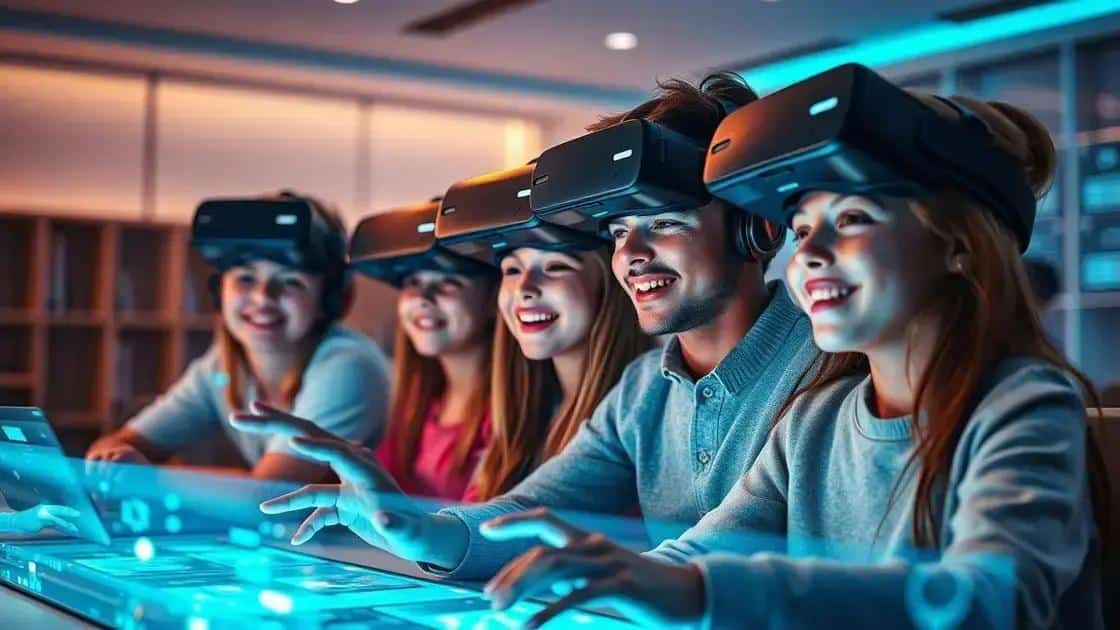
The benefits of VR learning environments are becoming increasingly clear. As schools and universities adopt this technology, students find themselves immersed in interactive worlds that enhance their learning journey. These environments not only captivate attention but also facilitate deeper understanding of complex subjects.
Engagement and Motivation
One of the most notable advantages is the heightened engagement students experience. When learners enter a VR world, they often forget they are in a traditional classroom setting. The immersive nature of VR captivates their interest, fostering a sense of curiosity and exploration.
- Students are more likely to participate actively in lessons.
- Learning becomes a fun and memorable experience.
- Motivation increases as students seek to explore more.
Furthermore, the ability to visualize and interact with educational content leads to better retention. When students can see and manipulate objects in a three-dimensional space, they can grasp concepts that were previously challenging. This hands-on approach to learning encourages them to connect theoretical ideas with real-world applications.
Collaboration Opportunities
Another significant benefit is the ability for students to collaborate within virtual spaces. Many VR platforms allow multiple users to share experiences, promoting teamwork and communication skills. Working together in a virtual environment helps students refine their ability to discuss ideas and solve problems collectively.
The collaborative aspect not only enhances learning but also prepares students for the workplace. Today’s jobs often require team-oriented skills, and VR provides a fun way to develop these abilities.
Personalized Learning
VR also allows for personalized learning experiences. Educators can tailor lessons to meet individual student needs. For example, if a student struggles with a particular concept, they can revisit VR simulations designed to strengthen their understanding in that area. This customization ensures that everyone can progress at their own pace, making learning feel less daunting.
As VR technology continues to improve, we can expect these benefits to expand even further. Students will have access to more varied learning materials, enriching their educational experiences like never before. By integrating VR into education, the goal is to create a dynamic learning environment where every student can thrive.
Challenges in implementing VR technologies
Implementing VR technologies in education comes with several challenges. While the benefits are clear, many educators face obstacles that can hinder the successful integration of these tools in their classrooms. Understanding these challenges helps institutions formulate better strategies for adoption.
Cost of Implementation
One major challenge is the cost associated with acquiring VR equipment. High-quality headsets and necessary software can be pricey, especially for schools that already operate on tight budgets. Many institutions must find creative solutions or secure funding to cover these costs. Additionally, ongoing maintenance and updates can add to the financial burden.
- Initial investment can be prohibitive for many schools.
- Regular updates and software costs can accumulate.
- Training costs for teachers to effectively use VR tools.
Solutions like partnering with technology companies or seeking grants can assist schools in overcoming these challenges.
Technical Barriers
Another significant hurdle is the technical knowledge required to implement and manage VR technologies. Teachers may not feel comfortable using new technology or integrating it into their lesson plans. Schools must provide adequate training and support to ensure educators can effectively utilize VR in their teaching. Introducing these technologies without proper training can lead to frustration for both teachers and students.
Furthermore, technical issues such as software glitches or compatibility problems can disrupt the learning experience. To address this, institutions can set up IT support for troubleshooting and maintaining equipment. Creating a structured plan for regular updates and technological maintenance can also help mitigate these issues.
Content Availability
The availability of suitable educational content is another challenge. Not all subjects have well-developed VR materials, which can limit teachers’ ability to incorporate this technology into their curriculum. As VR educational materials continue to develop, educators need guidance on how to find and utilize the best resources.
By collaborating with content creators, schools can foster the development of relevant VR materials that align with educational standards. This ensures that VR technologies can be effectively integrated into various subjects across the curriculum.
Student Accessibility
Finally, student accessibility to VR technologies poses a challenge. Not every student may have the opportunity to experience VR due to lack of resources or personal circumstances. Schools must work to create inclusive environments where all students can access learning experiences. This might include providing equal access to equipment and ensuring that VR experiences are designed with all learners in mind.
By addressing these challenges head-on, schools can develop comprehensive plans that enhance the implementation of VR technologies. With thoughtful strategies in place, educators can maximize the benefits of VR and provide exciting opportunities for their students.
Future predictions for VR in educational settings
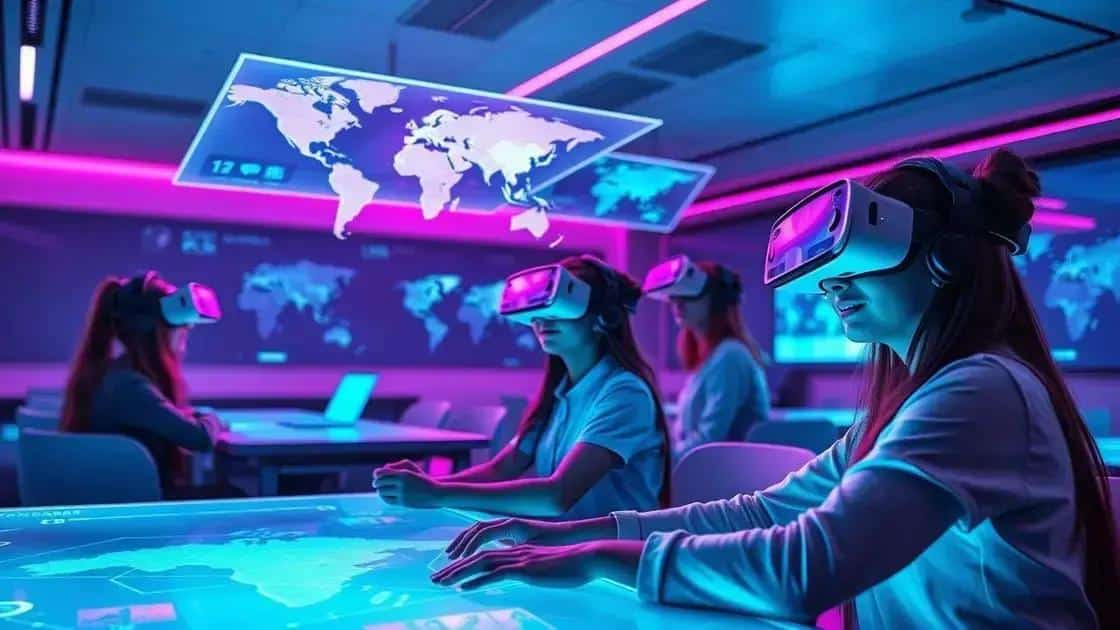
The future of VR in educational settings promises exciting advancements. As technology continues to evolve, educators and students can expect to see significant changes that enhance learning experiences. Many experts believe that VR technology will play a crucial role in shaping how education is delivered.
Increased Accessibility
One major prediction is the improved accessibility of VR tools. As prices decrease and technology becomes more user-friendly, more schools will be able to integrate VR into their curricula. This accessibility will allow students from diverse backgrounds to experience immersive learning environments.
- Affordable hardware and software options will emerge.
- Virtual field trips will become commonplace.
- More schools will adopt VR as a standard teaching tool.
With these advancements, students can explore distant places and complex concepts without leaving their classrooms, making learning more dynamic and engaging.
Personalized Learning Experiences
Another trend is the growth of personalized learning experiences through VR. As artificial intelligence integrates with VR technologies, the learning process will become tailored to each student’s needs. Educators can use data to create unique VR experiences that address individual strengths and weaknesses.
This approach ensures that students receive the support they need while encouraging them to advance at their own pace. By providing personalized content, education becomes more tailored and effective.
Collaboration Across Distances
Future VR educational settings will likely foster greater collaboration among students, even from different geographical locations. Students can work together on projects in virtual environments, sharing ideas and experiences as if they were in the same physical classroom.
The potential for global classroom exchanges will enhance cultural understanding and prepare students for a globalized workforce. This will not only enhance teamwork skills but also broaden students’ perspectives on different cultures.
Enhanced Teacher Training
In the near future, we can also expect improvements in teacher training through VR. As educators become comfortable using these technologies, training simulations will help them gain confidence in delivering lessons. This hands-on approach allows for practice in a safe environment.
Professional development programs can incorporate these VR experiences to help teachers learn new skills and strategies for engaging their students. Overall, these innovations will empower educators to leverage technology effectively in their teaching.
As we look at the future of VR in educational settings, it becomes clear that this technology will transform how we learn and teach. Increased accessibility and personalized learning experiences will empower students to thrive in dynamic environments. With improved collaboration, students can connect globally, enriching their education. Teacher training will also evolve, helping educators make the most of VR tools. Embracing these trends can lead to a brighter and more engaging future for education.
FAQ – Frequently Asked Questions about VR Learning Environments
What are VR learning environments?
VR learning environments use virtual reality technology to create immersive educational experiences, allowing students to interact with content in a 3D space.
How can VR benefit students in the classroom?
VR can enhance engagement, increase motivation, and improve understanding of complex concepts by providing hands-on, immersive learning experiences.
What challenges do schools face when implementing VR?
Some challenges include the high cost of technology, the need for teacher training, and ensuring access for all students.
What does the future hold for VR in education?
The future includes increased accessibility, personalized learning experiences, greater collaboration, and enhanced teacher training through VR technologies.
